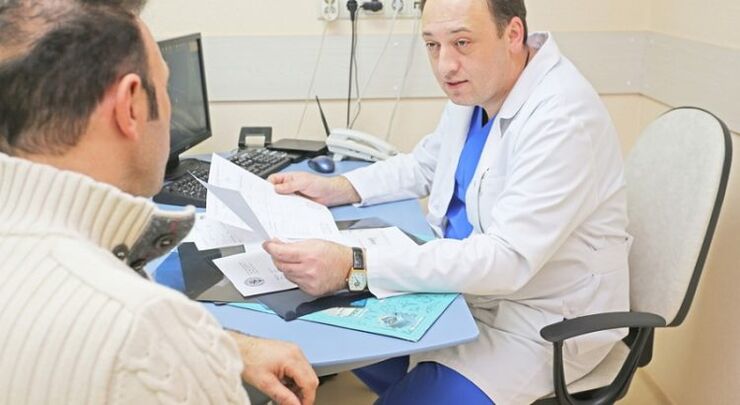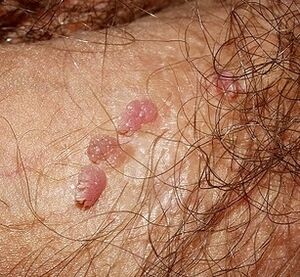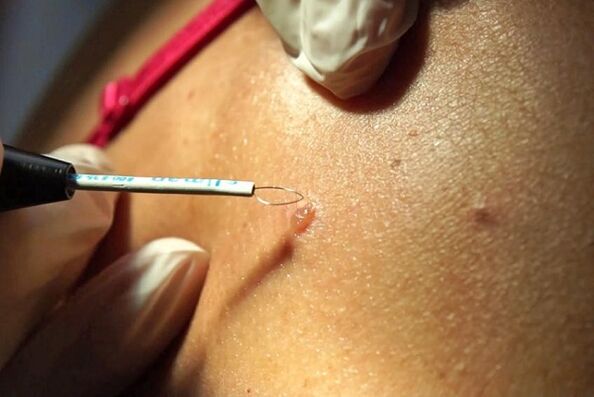
Most often, people are unaware that the human papillomavirus (HPV) is present in their body.This is due to the fact that the papillomavirus is usually present in a latent form, suppressed by natural immunity.Problems arise when it gets out of control and begins to actively manifest itself in the form of growths on different parts of the body.Men are less likely than women to suffer from the consequences of the virus, but even for them its effects can lead to serious problems in the form of papillomas on the penis.
Causes
Viral DNA enters the body through microcracks in the skin or mucous membranes.If a man's immunity is weakened, the first manifestations of HPV will appear several months after infection.
Up to 80% of transmission cases occur during sexual intercourse.Barrier contraception minimizes the risk of infection, but does not eliminate it completely.
Other routes of infection:
- Domestic way.The virus is transmitted through the personal belongings of an infected person: clothing, hygiene items, etc.The risk of transmission increases in the event of even minor skin lesions.This pathway is characterized by infection with low-oncogenic types of viruses.They do not cause serious health problems, but appear in the form of condylomas, papillomas and warts, creating an aesthetic defect.
- From mother to child.If a mother was infected with HPV during pregnancy and childbirth and gave birth naturally, the child is very likely to be infected.
If a man has good immune defense, the virus does not manifest itself and can remain in the body in a latent form for a long time.It is therefore not the infection with the virus itself that is dangerous, but the weakening of the immune system, which leads to the activation of HPV.
A number of factors influence the possibility of the virus strengthening:
- chronic diseases;
- hormonal problems;
- poorly selected contraception or its complete absence;
- viral infections;
- alcohol, smoking, or long-term antibiotic use;
- frequent stress.
All these factors negatively affect the immune system.If in a man's life there is not one provoking factor, but several, this will lead to a faster development of the papillomavirus.
Symptoms
Often papillomas appear only externally, but in some cases they can occurnon-specific symptoms:
- itching and burning during sex;
- pain when touching papillomas;
- accumulation of urine in the folds of the penis;
- unpleasant smell in the affected area.
In addition, neoplasms can grow and affect not only the penis area, but also appear on the anus and pubis.

What do papillomas look like?
Penile papilloma is a small neoplasm.At first, it may appear on its own, but without proper treatment, the number of papillomas increases.At the same time, they can merge with each other.
These new shoots look like flesh-colored or pink cauliflower inflorescences.Most often, they are located at the level of the foreskin, on the head and the frenulum.More rarely, they are diagnosed in the urethra and scrotum.Papillomas can also appear as small white bumps arranged in long rows.This shape is typical for localization in the brake area.
One of the manifestations of HPV is Buschke-Levenshtein condyloma.It is characterized by rapid growth, exceptional size and resistance to various types of treatments.Its appearance is due to several existing papillomas and condyloma, which merge and form a large affected area.The presence of Buschke-Levenshtein condyloma is dangerous because the altered cells can easily develop into cancer.
Which doctor should I contact?
Typically, a urologist diagnoses papillomas in men.You can also consult a dermatovenerologist or a proctologist if you have warts in the anal region.However, to remove papillomas, they are usually referred to a surgeon.In total, the diagnosis takes place in several stages:
- The urologist examines and questions the patient.An oral interview is necessary to assess the patient's lifestyle and determine the cause of the virus infection.A visual examination involves not only assessing the condition of the penis, but also adjacent organs - the scrotum, anal region.This is necessary to complete the picture of the location of the virus.
- Submit a urethral smear.Determines the presence of various sexually transmitted diseases.
- PCR.This analysis not only shows the presence of HPV in the body, but also most likely determines its type.
- Metoscopy.This procedure is an examination of the urethra if the papillomavirus has affected the frenulum.
- After removal of the papillomathe doctor may order a biopsyto assess the status of a distant tumor.This is necessary to eliminate the risk of cancer and ensure that the papilloma is benign.
In this case, both partners should be examined.Usually the woman is also infected with one of the types of papillomavirus.If only one man is treated, he risks getting sick again after a while.
Why are papillomas dangerous?
Human papillomavirus is often accompanied by other related diseases.The appearance of papillomas on the glans contributes to the accumulation of urine in the folds.This creates favorable conditions for the emergence and growth of various microorganisms, which subsequently leads to infections.They can cause erosion around the papilloma and also contribute to inflammation of the urethra and testicles.These diseases are characterized by problems urinating, pain and high fever.
Another danger is injury to tumors, which leads to bleeding.This is due to the fact that numerous blood vessels form around the papillomas, which supply them with blood.Even minor damage can lead to infection from trauma.
Also, neoplasms can rub during movements, which causes pain and discomfort in men.
HPV and cancer
When the virus is just beginning to spread, neoplasms are rare and benign.Without treatment, they grow and merge with each other.Over time, the cells degenerate into malignant cells.The risk of cancer is especially high if a man is infected with highly oncogenic types of viruses - 16 or 18.They contribute to the development of penile and bladder cancer.
Treatment of papillomas
Treatment of HPV involves not only eliminating its external manifestations, but also strengthening the immune system, which should block the manifestations of the virus.To maintain immunity, immunostimulating drugs are used.
An ointment that suppresses the multiplication of the virus and eliminates small growths is effective as an antiviral drug.It does not always completely eliminate the plant, but it prevents the appearance of new growths.To stimulate the immune system, an antiviral ointment is prescribed.The ointment does not eliminate papillomas, but helps activate cells of the immune system, which stops their growth and development.

Removal Methods
There are several ways to get rid of emerging tumors:
- Laser removal.The papilloma is exposed to a laser beam which completely burns the growth.A crust forms there and falls off after a few weeks.The method is considered effective due to the absence of relapses.The removal is carried out under anesthesia.In this case, there is no bleeding, no scars or scars remain.
- Cryodestruction.Papillomas are exposed to liquid nitrogen.It instantly freezes the desired area, the neoplasm located there is destroyed and dies.The disadvantage of this method is the inability to control the depth of cryodestruction.A crust also remains at the site of the removed papilloma, disappearing after a while.
- Radiosurgery.The principle of operation of this method is similar to that of laser removal.Radio waves do not leave scars and the procedure is preceded by preliminary anesthesia using a special spray.There are then no complications and the body recovers quickly.
- Electrocoagulation.The growth is exposed to an electric current, due to which the stem is removed, after which the papilloma disappears.If necessary, superficial anesthesia can be used.The procedure takes a few minutes, is widespread and affordable.But this method can leave scars after healing.
- Surgery.It is used in rare cases where the tumor becomes too large.It is done under anesthesia and is characterized by long healing and trauma.The advantage of this method is that it allows the removed growth to be preserved for histological examination.
The price of each method depends on the complexity of the work, the size and number of papillomas to be removed.
Before choosing a method, consult your doctor.He will tell you what is best to use in your situation and explain in detail how the procedure is carried out.Additionally, after removing the tumor, it is advisable to take the material for histology.This is necessary to determine whether the process of degeneration of benign neoplasms into malignant neoplasms has begun.This method will help detect early cellular changes and prevent the spread of cancer.























